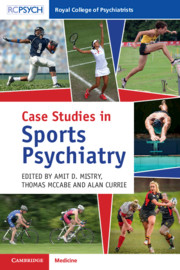Book contents
- Case Studies in Sports Psychiatry
- Reviews
- Case Studies in Sports Psychiatry
- Copyright page
- Contents
- Editors
- Contributors
- Foreword
- Preface
- Chapter 1 American Football: Cognitive Impairment
- Chapter 2 Athletics: Energy Levels, Exercise Addiction and Disordered Eating
- Chapter 3 Boxing: Low Mood and Gambling
- Chapter 4 Cricket: Mental Health Emergencies
- Chapter 5 Cycling: Attention Deficit Hyperactivity Disorder and Anti-Doping
- Chapter 6 Football: Alcohol and Barriers to Support
- Chapter 7 Golf: Alcohol, Anxiety and Sleep Problems
- Chapter 8 Rugby: Concussion and Mental Health Symptoms
- Chapter 9 Swimming: Adolescent Athlete Training Commitments
- Chapter 10 Tennis: Trauma and Tours
- Appendix: International Society for Sports Psychiatry Curriculum 2018
- Index
- Plate Section
- References
Chapter 10 - Tennis: Trauma and Tours
Published online by Cambridge University Press: 29 July 2020
- Case Studies in Sports Psychiatry
- Reviews
- Case Studies in Sports Psychiatry
- Copyright page
- Contents
- Editors
- Contributors
- Foreword
- Preface
- Chapter 1 American Football: Cognitive Impairment
- Chapter 2 Athletics: Energy Levels, Exercise Addiction and Disordered Eating
- Chapter 3 Boxing: Low Mood and Gambling
- Chapter 4 Cricket: Mental Health Emergencies
- Chapter 5 Cycling: Attention Deficit Hyperactivity Disorder and Anti-Doping
- Chapter 6 Football: Alcohol and Barriers to Support
- Chapter 7 Golf: Alcohol, Anxiety and Sleep Problems
- Chapter 8 Rugby: Concussion and Mental Health Symptoms
- Chapter 9 Swimming: Adolescent Athlete Training Commitments
- Chapter 10 Tennis: Trauma and Tours
- Appendix: International Society for Sports Psychiatry Curriculum 2018
- Index
- Plate Section
- References
Summary
AB is a 17-year-old, English athlete and college student, in the midst of transition into professional tennis. She is academically highachieving and got straight As in school examinations around three months ago. Following her results she immediately left to compete in an international pro circuit tennis event. While abroad and dining in a restaurant, she and her coach directly witnessed a mass shooting. Two people were killed and others were wounded at the scene. One died from their injuries later. A knew nothing about the reasons for the attack, nor did she know the deceased. She had tended to a neck wound in one injured person, while a crowd of people waited for emergency services to arrive on scene. This victim passed away despite prolonged attempts to resuscitate him.
- Type
- Chapter
- Information
- Case Studies in Sports Psychiatry , pp. 122 - 133Publisher: Cambridge University PressPrint publication year: 2020



